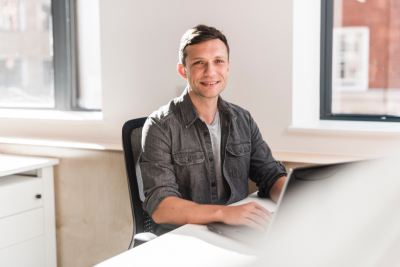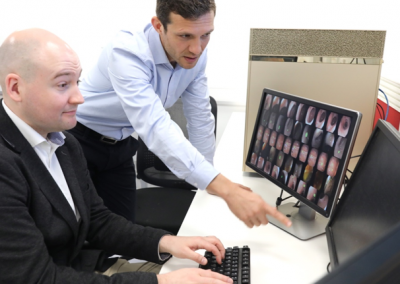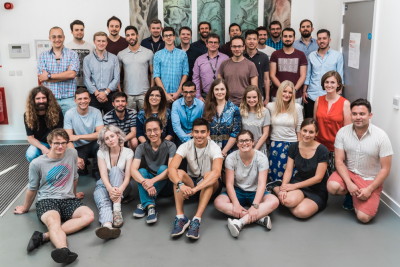Spotlight on Prof Danail Stoyanov, new WEISS Director
24 June 2019
We are delighted to announce that Professor Danail Stoyanov has been appointed the new Director of the Wellcome / EPSRC Centre for Interventional and Surgical Sciences (WEISS).

WEISS researchers are working at the forefront of advances in interventional health and surgery, developing cutting-edge technologies like artificial intelligence, robotics, 3D printing and advanced imaging to realise impact and improve patient’s lives.
Dan is UCL Professor of Robot Vision and his own research expertise is in surgical vision and robotics. We interviewed Dan to discuss his exciting plans for the Centre’s next years, the support for clinical translation that WEISS provides and the benefits that engineering and medicine’s colocation brings in ensuring that clinical pull always comes first and foremost.
Congratulations on your appointment as WEISS Director! How long have you been involved in the Centre?
I’ve been involved in the Centre since its start two years ago and previously in developing the original vision. After acting as Deputy Director for the past year, I’m delighted that my role has transitioned to this leadership position at such an exciting time for WEISS.
And why do you feel that this is a particularly exciting time for WEISS?
WEISS is going through a real moment of growth. There are fresh academic staff, new ideas flourishing and expansion into both new scientific areas, such as intra-operative pathology, and clinical specialities such as skin cancer surgery, that we weren’t previously involved with. The synergies occurring between all of the multi-disciplinary investigators and their expertise are driving the Centre to be a hub of engineering and scientific excellence with the means to translate research into clinical trials and be more than the sum of its parts.
Crucially, whilst fresh faces are coming into the Centre we are also seeing more established aspects reaching points of maturity. After two years’ progress, some of the core technologies are at the fringe of imminent early human trials. Seeing the foundations of the Centre come into fruition in this way is thrilling.

What is so unique about the environment of WEISS?
WEISS is uniquely positioned as a Centre with colocation of engineers, scientists and clinicians. Having different experience in one building is crucial in developing research that is able to make real impact. The development and translation of healthcare technologies require constant clinical input in order to be usable and useful. Putting clinicians at the centre of the whole research process means that we are always focused on developing usable technologies and solving identifiable problems.
As engineers, it can be easy to think up blue sky ideas but the environment at WEISS keeps us focused on the real challenges and their solutions which can impact the lives of patients.
You mention that this helps accelerate translation. Can you tell me more about how WEISS enables and supports a translational push?
The translational pipeline can have many unanticipated stumbling blocks including issues with ethics and regulatory approvals. These can cause delays that impede the progress of a project or idea. At WEISS, we have expertise specifically dedicated to these areas and to navigating the various processes.
An excellent example of translation in the Centre is the SmartTarget system, which guides surgeons performing biopsies and improves prostate cancer detection. The system is now CE certified to be sold as a medical device. Crucially, the basis for the regulatory framework is now being taken up by another one of our start-ups, Odin Vision. Odin Vision uses artificial intelligence to analyse live colonoscopy video, identifying and characterising polyps for early detection of bowel cancer.
Excitingly, this means that the regulatory framework developed for one particular translational project is now being used in another translational project! And there’s a number of other earlier stage projects that are also investigating how they can take advantage of our capabilities.

Dan with Odin Vision CEO, Peter Mountney (above)
What are some of your next priorities for the Centre?
Continuing to push along the translational pipeline and having active clinical trials of the various technologies that we are supporting is a priority.
We’ve also set up a small, but very active, incubator scheme with spin-outs SmartTarget, Odin Vision and Echo Point situated with us in WEISS. The potential to expand this would be another exciting avenue for us.
Your own research is focused on surgical robot vision, what does this really entail and what is its potential?
Surgery is increasingly performed minimally-invasively, with cameras and tools inserted into the body or through other interventional imaging. This has a number of benefits including less patient trauma, faster recovery and reduced hospital costs. However, we aren’t making good use of the data being produced.
The images of internal anatomy can provide us with motion, size and a number of other things that we’ve never really observed in any quantitative way before, and have never analysed with respect to variations across diseases, genetics, geographics and so on.
By applying artificial intelligence and computational technologies, there is a really exciting opportunity to utilise this previously unused data in a way that will advance our fundamental understanding and also optimise treatment choices and outcomes for patients.
Any final thoughts?
Firstly, a huge thank you to Prof David Hawkes who I am taking the Directorship over from. Dave has been instrumental in driving the field of medical image computing on an international level. It’s difficult to work in this space without knowing Dave and, often, without training with him! His computational imaging efforts over the past years have underpinned many of the grants and projects that underpinned WEISS and paved the way for the vision of the Centre. It’s an honour to be able to build on this now that I’m Director and it’s an even greater pleasure to retain his invaluable advice and support moving forward.
I’d also like to thank all of the investigators that are engaged in the Centre, both technical and clinical. They really are the heartbeat of WEISS and it’s through their efforts that any success happens, allowing us to keep pushing for better patient treatment and better patient outcomes.
For the younger scientists at WEISS, I will continue to strive to make the Centre an inspirational place for you to work, both technically and through seeing the clinical impact that your research can make.

All our efforts are a truly interdisciplinary endeavour, bringing together teams across engineering, medicine, life sciences, biology, chemistry, physics and computational science – all under one roof!
 Close
Close

